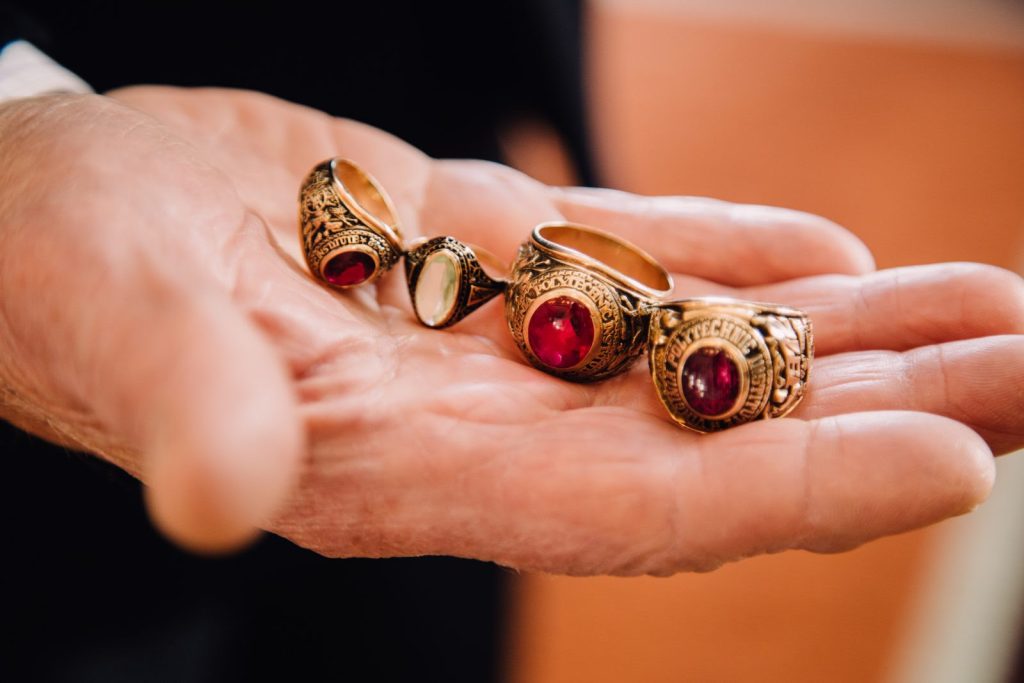Talking about his father, his father’s 1942 Virginia Tech class ring, his mother’s miniature ring, and the opportunity to add to his family’s legacy with Virginia Tech brought forth all sorts of emotions for Travis “Rusty” Unterzuber.
Six months ago, he and his sisters weren’t sure what to do with the rings of their now deceased parents. Then by chance, Unterzuber remembered the Hokie Gold Legacy Program, which allows alumni or families of alumni to donate class rings to be melted to create “Hokie” gold that is included in future class rings.
A family discussion ensued, and they agreed they wanted to be a part of the program.
“I knew the program was there, and I knew we had rings,” Unterzuber said. “Never got the two together until about six months ago.”
In late November, Unterzuber made the 15-hour drive from his hometown of Davenport, Iowa, to Richmond to visit with family relatives during the Thanksgiving holiday. Then he worked in a visit to Blacksburg to be a part of the ring melting ceremony held at the VTFIRE Kroehling Advanced Materials Foundry on Virginia Tech’s campus.
The ceremony, held Nov. 29, has taken place annually since 2012 and even took place last year, though with just the 2022 class president in attendance because of a COVID-related restriction in the number of people allowed in the facility. This unique tradition of bridging the past and the future started when two class members from the 1964 M Company of the Virginia Tech Corps of Cadets — Jesse Fowler and Jim Flynn — came up with the idea.
Laura Wedin, associate director for student and young alumni engagement, coordinates the program, collecting rings from alumni who want their rings melted and removing the stones from them. She also keeps track of donation forms and biographies of ring owners and sends email verification upon receipt of rings that have been shipped.
In addition, Wedin coordinates the gold melting ceremony, which includes Bugle yearbooks that represent the years of the rings being melted. Donor rings get placed on the open page of an alumnus or an alumna, and current ring design committee members then transfer each of these rings to a graphite crucible, saying the name of the alumnus or alumna or spouse who originally wore the ring and the class year before dropping the rings into the cylinder-shaped object.
Unterzuber brought three rings to be melted: his father’s class ring, his mother’s miniature ring, and wife Doris’s engagement ring. Unterzuber and his wife were married in 1972, the same year in which he graduated.
His father’s class ring had been given to his younger sister, Kaete, by their mother after his father’s passing, and Kaete Unterzuber agreed to donate the ring for melting. His mother’s miniature ring had been left to his wife after his mother’s passing, and Doris Unterzuber agreed to donate that ring for the proceedings.
Unterzuber’s father came to Virginia Tech on a football scholarship in 1938, was a member of the Corps of Cadets during his time at Virginia Tech, and after graduating with a degree in agricultural engineering, went on active duty. His father and mother married in 1942 with the miniature ring serving as the engagement ring.
Unterzuber also donated his class ring. Next year marks the 50th anniversary of his graduating from Virginia Tech. His ring, though, was not one of the eight melted. Instead, Virginia Tech plans to store his ring in a “time capsule” being constructed near Burruss Hall as part of the university’s sesquicentennial celebration commemorating its 150-year anniversary.
Now retired after following in his father’s footsteps and graduating with a degree in agricultural engineering before working in the farm equipment industry, Unterzuber attended the ceremony along with a handful of members of the ring design committee and the 2023 class president. Once filled with rings, the crucible gets taken into the foundry where Alan Druschitz, an associate professor in materials science engineering, oversees the process.
The crucible ultimately is placed into a small furnace heated to 1,800 degrees, and within 20 minutes, the gold turns into liquid form.
The gold bar from the eight rings weighed 6.315 ounces. Wedin then ships this gold bar to Balfour, the company that makes Virginia Tech’s class rings, and workers there refine the gold, using it to cast Virginia Tech’s class rings for the upcoming year. They also reserve a very small amount from each melt to include in future years’ ring melts.
Each gold class ring today consists of 0.33 percent “Hokie gold.” Thus, each student symbolically is connected to Virginia Tech alumni from the past.
Photos and videos were taken during and shared on social media platforms, educating friends, classmates, and the general public about a tradition that few seem to know. More importantly, the evening stirred reflection among the students in attendance about their future legacies and possible participation down the road with their own class rings.





